Ayrton Senna, 30 years on: The one call that could have kept F1 legend alive
The Greatest of All Time debate in any sport is always a difficult one to argue. Rules change, leagues professionalise, the game evolves.
Statistically, Lewis Hamilton is F1's GOAT. While his seven world championships only equal him with Michael Schumacher, he's won more races, taken more pole positions, and led more laps than any other driver in the history of the sport.
Granted, there are more races now than in Schumacher's era, but stats are stats and records are made to be broken.
READ MORE: Broncos rocked by season-ending injury to star
READ MORE: Brutal head knock gives debutant special chance
READ MORE: Raiders win after 'one of the plays of the season'
That aside, when the debate shifts to who has the most natural talent, Ayrton Senna is at the top of the list. His death 30 years ago this week rocked not only the motorsport community but the wider sporting world.
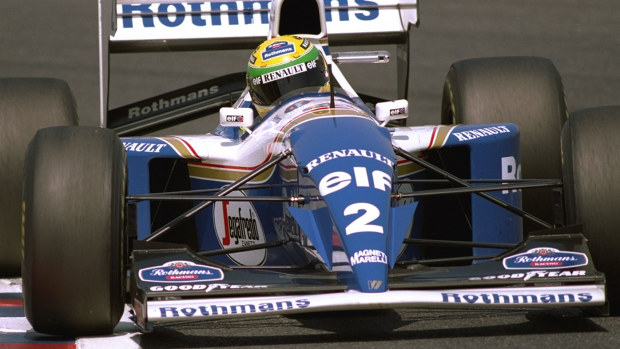
Ayrton Senna in action for Williams in 1994. AAP
He had a style like no other. When in the car, he only operated on the absolute limit of what it was capable of. He could drag a dog of a car to heights it had no right to.
While Alain Prost – the Frenchman with whom he shared his most fierce rivalry – was calculated and unflappable with a buttery smooth driving style, Senna was ragged, unyielding and emotional.
He was fiercely competitive – sometimes to his detriment – and winning simply wasn't enough. While Prost was quite content to win the race driving as slow as possible, Senna had to dominate.
Pat Symonds worked with him at Toleman, with whom Senna made his F1 debut in 1984. He famously recalls a race in Dallas that season where Senna clipped a wall on the exit of a corner. The damage took him out of the race.
From the outside, it looked as though Senna had simply made an error, but so confident was he in his own abilities, he was insistent that was not the case.
Symonds said Senna was sure the wall had moved – to which he scoffed. Senna was, after all, only human. Plus, he was only in his first season of F1 – surely not even the most experienced of drivers would have believed the wall would have moved.
But Symonds decided to humour Senna, and the pair walked to the scene and had a look.
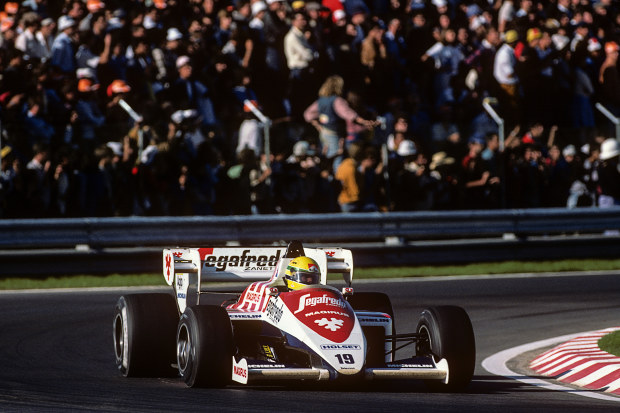
Senna made his debut in 1984 driving for Toleman, pictured here at that year's Portuguese Grand Prix. Getty
Sure enough, another car had clipped the far end of the wall, which had knocked the leading end out of alignment by no more than a few millimetres. It was enough to take Senna out of the race.
Senna knew exactly where the very limit was, without crossing it.
He died a three-time world champion with 41 race victories and 65 poles to his name. There is no doubt he would have won more.
Many, many more.
It had been more than a decade since the last death at a race weekend (Riccardo Paletti at the 1982 Canadian Grand Prix), and more than eight years since a driver had died driving modern F1 machinery (Elio de Angelis at a private test for Brabham at Circuit Paul Ricard in 1986).
And even that was more down to the utter ineptitude of trackside marshalls than any fault of the car.
When the series arrived at the Imola circuit for the 1994 San Marino Grand Prix, racing an F1 car was as safe as it had ever been.
But on that weekend, four serious crashes – two of which resulted in fatalities – changed the sport forever.
This is the first of a two-part Wide World of Sports special on the 30th anniversary of the death of Aryton Senna. Part two will be published on Sunday.
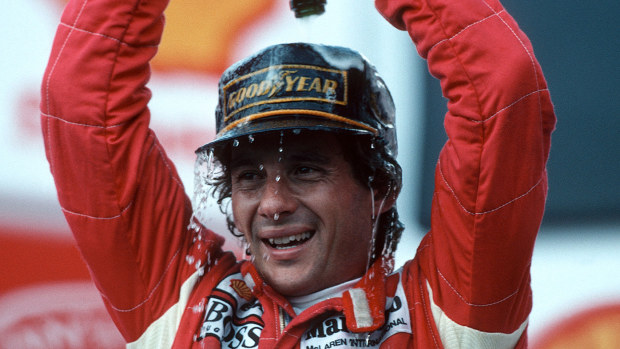
Senna celebrating one of his many wins for McLaren Getty
The story so far
Senna shocked the sport in 1993 when he announced he would leave the McLaren team with which he had won each of his three championships to join Williams.
With its radical active suspension system, Williams had dominated the sport in 1993 through his nemesis Alain Prost. McLaren couldn't keep up, which prompted Senna – who only ever wanted to drive the fastest car – to jump ship.
Prost and Senna were teammates at McLaren in 1988-89, where they shared a fierce rivalry that eventually saw Prost leave for Ferrari for 1990. He didn't want to team up with Senna again, and promptly retired.
But for 1994, the FIA – the sport's governing body – banned a raft of electronic driver aides, among which was the active suspension system, as well as traction control.
In his 2017 book How to Build a Car, Williams' then-technical head Adrian Newey (who has been at Red Bull since 2006, and has designed the car that's claimed each of the team's seven world titles with Sebastian Vettel and Max Verstappen) explained losing active suspension gave the car a massive aero imbalance, which had taken him and his engineering team some time to get their heads around.
It left Senna seriously unhappy with the drivability of the car. He couldn't push it to the limit like he wanted to.
He was so unhappy, he'd even begun talks with Ferrari about a potential drive for 1995 – although few knew of those talks at the time.
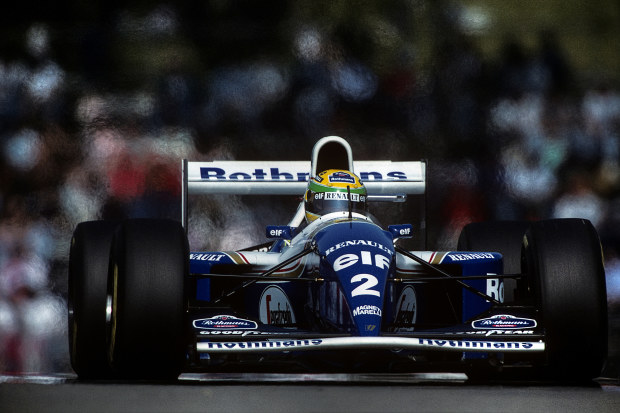
Senna earlier in 1994 San Marino Grand Prix weekend. Getty
Somehow, Senna had taken pole at both the first two races of the season at his home Brazilian Grand Prix, and then again in Japan. Nobody within the Williams team believed the car had any right to be there. Senna was just a freak.
In Brazil, he made a mistake and spun out of the race. Then at the Pacific Grand Prix in Japan, Michael Schumacher in the Benetton got the better start and beat him to the first corner. Senna was then tipped into a spin by the McLaren of Mika Hakkinen – who was his teammate briefly late in 1993 – and then hit by Nicola Larini.
Two races, zero points.
To make matters worse, Senna was convinced the Benetton team were running some kind of illegal traction control system on their cars – or at least Schumacher's, anyway. After his crash in Japan, Senna watched the race from trackside and claimed Schumacher's car sounded different on-throttle to all the others.
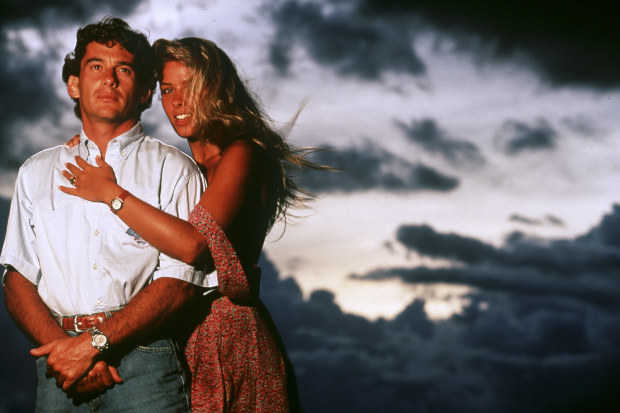
Ayrton Senna and his girlfriend Adriane Galisteu in February 1994. Gamma-Rapho via Getty Images
Senna was also in a relatively fresh relationship with girlfriend Adriene Galisteu. Newey said his family didn't approve of her, which, given his fierce loyalty to his family, in itself was a source of angst.
All of this head noise meant by the time Formula 1 arrived in Imola, the third race of the season, Senna was not a happy man.
But one thing was certain – he was desperate to win.
Crash No.1 – Barrichello
During Friday qualifying, Senna's countryman Rubens Barrichello suffered the first major crash of the weekend after he lost control at the ultra-fast right left, left right Variante Bassa chicane at the end of the lap.
In those days, the kerbs that lined the tracks were high with incredibly steep faces. When Barrichello hit the kerb on the exit of the chicane, his Jordan was launched into the air. It crashed into a tyre barrier, rolled several times, and came to rest upside-down in the sand.
F1's lead doctor, Professor Sid Watkins was among the first on the scene. Barrichello had left the road at more than 220km/h, and had swallowed his tongue in the impact. If anyone other than Watkins had arrived, Barrichello would have suffocated.
He escaped with only a severe concussion and a broken nose, and would be a spectator for the remainder of the weekend. Senna visited him in hospital that night.
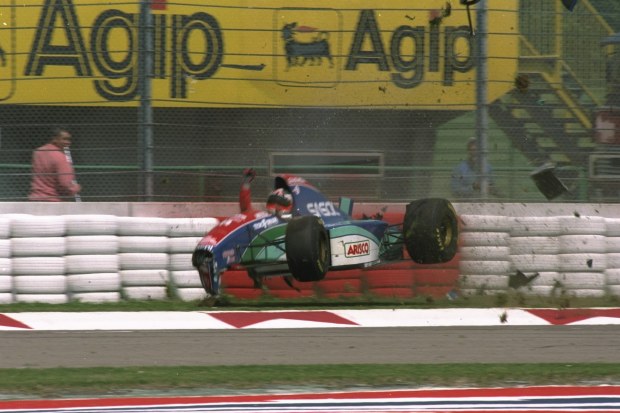
Rubens Barrichello of Brazil crashes at 160 mph in his Jordan Hart during the first official practice for the San Marino Grand Prix at the Imola circuit in San Marino. Barrichello escaped serious injury. \\ Mandatory Credit: Anton Want/Allsport Getty
Australian David Brabham was driving for the brand new Simtek team in 1994.
The youngest son of Aussie motor racing doyen Sir Jack Brabham, David had driven for what was once the family team in his debut F1 season in 1990. Jack had well and truly sold the Brabham team by then, and it was in dire financial trouble. David was forced out at season's-end. The team folded in 1992.
Speaking to Wide World of Sports, Brabham said Barrichello's crash had certainly got the paddock's attention.
"It was certainly an accident that everyone went 'phwoar, holy dooley that was a big one'," he said.
"Rubens was obviously lucky to get out of that one, and he couldn't race. It certainly left an impression."
Although nobody knew it, worse was still to come.
And Brabham's Simtek team would be in the middle of it.
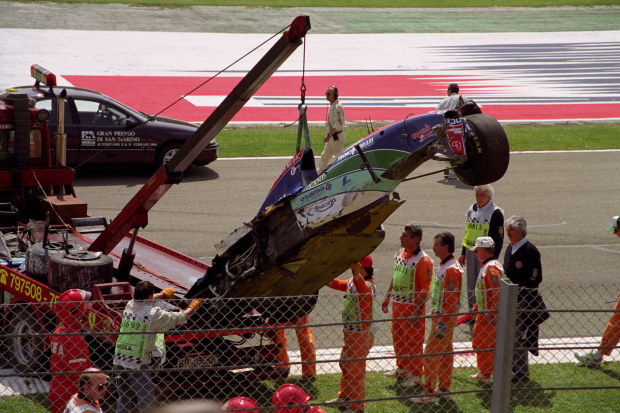
The crashed car of Rubens Barrichello is cleared from the track during Friday qualifying for the 1994 San Marino Grand Prix. (Photo by Steve Etherington/EMPICS via Getty Images) PA Images via Getty Images
Crash No.2 – Ratzenberger
Simtek were the new kids on the block in 1994.
The team was headed by Nick Wirth, a young and incredibly bright engineer. He hired Brabham and Austrian Roland Ratzenberger as their two pilots for the start of the 1994 season.
Reliability in those days was such that getting to the finish line of a grand prix was an achievement in itself, and they had managed to get a car to the finish line in each of the first two races – Brabham in Brazil and his teammate in Japan. A remarkable achievement.
Brabham said optimism heading into Imola was high, and was even higher after a brake issue that had been plaguing Ratzenberger in the first two races was fixed.
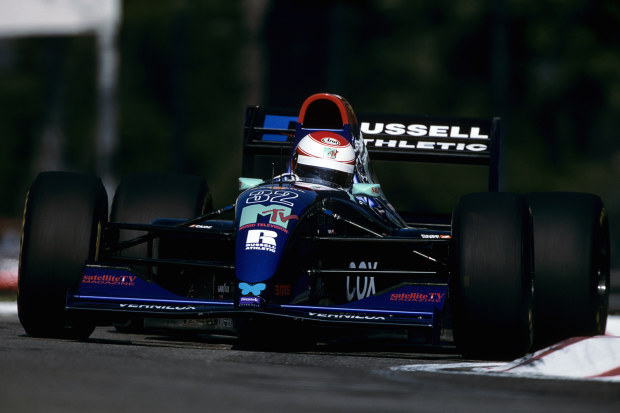
Roland Ratzenberger during practice for the 1994 San Marino Grand Prix. Getty
Aged 34, Ratzenberger was in his first season of F1. Even in those days, 34 was old for a rookie. He'd shown promise in the junior formulae, but had never got a chance at the highest level.
Midway through Saturday qualifying, his front wing failed at the Villeneuve curve and he crashed into a bare concrete wall.
A lap before the crash, Ratzenberger had made an error and struck one of those high kerbs at the Acque Minerali chicane.
Although missed by TV cameras, the car's data shows once back on the track, he weaved side-to-side to check for any damage to the suspension or steering, or a puncture.
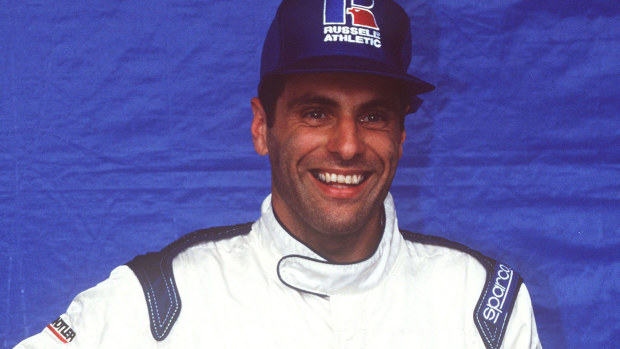
Ratzenberger was in his debut season of F1. Getty
They were both fine, so he started another push lap. There was no way he could have known his wing was damaged.
In those days, there was a some 1.6km long flat out section of the track that stretched from the Variante Bassa chicane – the scene of Barrichello's crash – through the Tamburello and Villeneuve corners up to the Tosa hairpin.
At Villeneuve, the aerodynamic forces upon the car's wings peaks. It was here Ratzenberger's front wing failed.
The wing slid under the front wheels and lifted them off the ground. With no steering and virtually no brakes, Ratzenberger was a complete passenger heading directly towards a bare concrete wall at speeds well north of 300km an hour.
Sensors in the car measured the head-on impact with the wall at 500g – that's 500 times his own bodyweight. To this day, it remains the highest ever recorded in a F1 crash.
Brabham was on the track too and was on the main straight starting his own push lap when the red flags flew.
"As I came down the straight, I could see parts of a car on the straight and they were purple. My immediate reaction was 'shit, that's Roland'."
Ratzenberger's car had come to rest in the middle of the track at Tosa. Brabham arrived on the scene at the same time as a medical car.
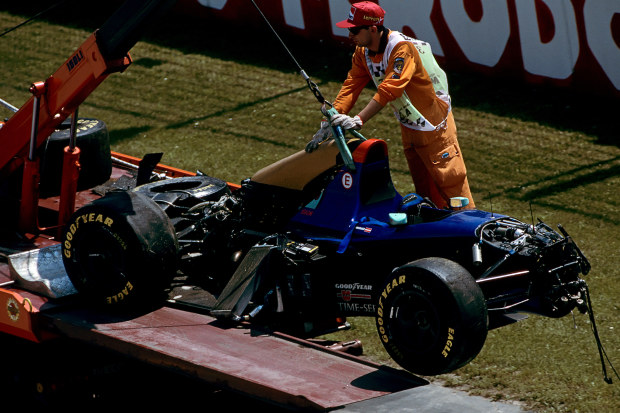
The remains of Roland Razenberger's car after his fatal crash during qualifying for the 1994 San Marino Grand Prix in Imola. (Photo by Paul-Henri Cahier/Getty Images) Getty
The angle of Ratzenberger's car gave Brabham a clean view of his teammate. It wasn't a good one.
By the time Brabham arrived back in pit lane, it was clear the situation was dire.
"I remember my wife, Lisa was there, she was pregnant with our son, Sam, and she asked 'you know, what do you think?'
"I just said, 'well, I think he's gone'.
"I just sensed there was no life there. I saw the way, the position of his head, it just didn't look right. And it was an energy thing. I just had a sense he wasn't there anymore."
Ratzenberger was flown straight to the Maggiore Hospital in Bologna – the second driver taken there that weekend.
He was pronounced dead on arrival, but he was almost certainly killed on impact.
While a basilar skull fracture (basically the most severe whiplash injury) was ruled the official cause, an autopsy showed it was one of three separate fatal injuries. Blunt trauma (from the front-left tyre penetrating the car's survival cell) and a ruptured aorta the other two.
It was Italian law at the time that if a driver competing in a motor-racing event was killed on impact, the entire race meeting must be cancelled.
Although obviously never confirmed, it's widely believed the hospital was pressured by local authorities to declare him dead on arrival so the race meeting could continue. Sid Watkins may also have been able to make that call.
How different Formula 1 might have looked today, had that not occurred.
Back at the track, the Simtek team had unsurprisingly elected not to take any further part in qualifying. When confirmation later came through of Ratzenberger's death, the team had a decision to make.
Before the crash, Brabham had set a lap time that was fast enough to make the grid, as he had done in Brazil and Japan.
So, should he race?
While death was a regular part of racing during his father's career, nobody had ever been killed at a race meeting David was competing in. Many other drivers were in the same boat.
"It was a new experience for me. Everybody was in a state of shock," he said.
"For me it was like, 'what the hell's going on? What do I do?' Everybody was numb. You just didn't know what to do, what to think, what to do next."
Brabham said much of that afternoon is a blur, but recalled sitting in a meeting in the Simtek motorhome with Wirth, F1 supremo Bernie Ecclestone, and FIA president Max Mosley.
The decision was left up to Brabham.
"Nick said 'look, the decision to race is 100 per cent entirely up to you. If you don't wanna race, that's perfectly fine, we'll pack up and go home. But if you want to race, we will support you as well'," Brabham explained.
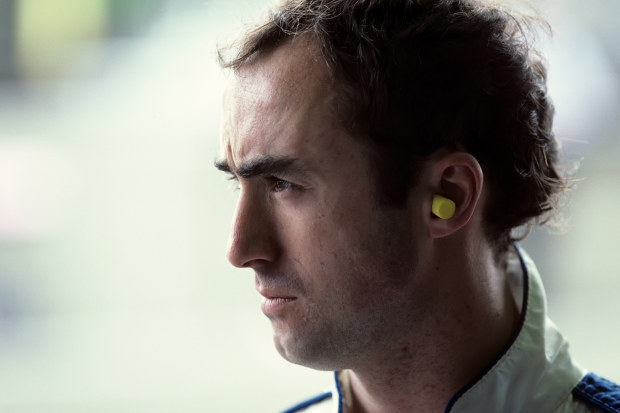
Aussie David Brabham (Pictured at the Brazilian Grand Prix in 1994) was teammates with Roland Ratzenberger. Getty
"I didn't really know what to do, My brain was kind of going, 'I don't want to race', and then you think well, Roland would be saying 'mate, you're a racer – get back in the car and go racing!'
"All these things go through your mind and you become confused a bit. I didn't feel I was in a position to make a call during that evening."
The decision at that point was to come back on Sunday morning, take part in the morning warm-up, and see how everyone was feeling. So that's what they did.
Having found out on the Saturday night Ratzenberger's crash was caused by a front wing failure, Wirth also worked through the night to strengthen the wing on Brabham's car to avoid a repeat.
On Sunday morning before the warm-up, he demonstrated its strength to Brabham by quite literally jumping on it.
On track, Brabham was quicker in the warm-up than he was on Saturday.
"I'm pretty sure they didn't put me on full (fuel) tanks like everybody else … we were probably five or six spots higher in the standings than we had been," he said.
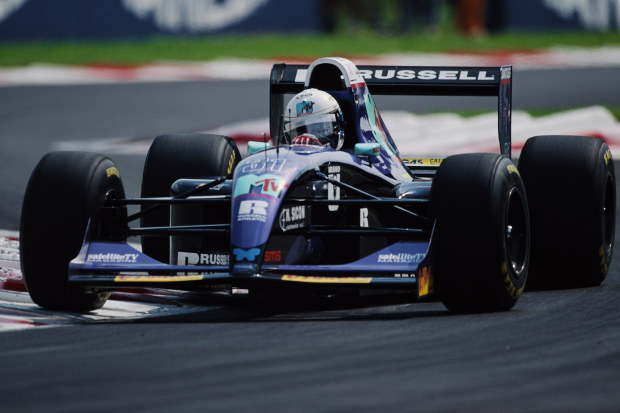
Brabham at the Italian Grand Prix later in the year. Getty
But it had the desired effect.
"I just sensed a slight lift of mood in the camp. There were such dark clouds over the team, but it gave people a little bit of hope and that's what I picked up on and so I ran with that.
"I thought 'we've got to keep going. I've got to race for these guys and pick these guys up'.
"And that was then when I decided, 'OK, I'll race'."
And so he did, although a steering failure saw him end his race in a sand trap about halfway.
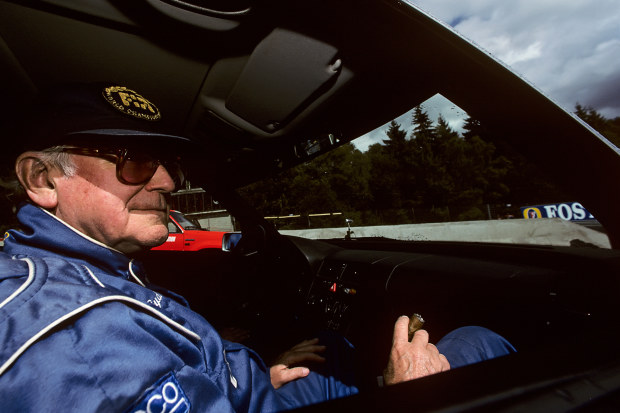
Professor Sid Watkins, neurosurgeon and official Formula One race doctor at the 1996 Belgian Grand Prix. (Photo by Paul-Henri Cahier/Getty Images) Getty
'Let's go fishing'
As was the case in the first two races, Senna had qualified on pole from Schumacher.
Senna didn't have many friends, but Ratzenberger was one of them. Unsurprisingly, he was rattled by his death.
In his 1996 book Life at the Limit, Sid Watkins recalled Senna visited him on the Saturday night. Like Ratzenberger, Senna and Watkins were close friends, and shared a passion for fishing.
"Ayrton, why don't you withdraw from racing tomorrow," Watkins told Senna.
"In fact, why don't you give it up altogether? What else do you need to do? You have been world champion three times, you are obviously the quickest driver. Give it up and let's go fishing."
It was true – Senna had nothing else to prove. He already had several charities in Brazil – perhaps he could dedicate his time fully to running those? Many people already believed he would one day be president of Brazil.
Senna thought about it for a moment, but declined.
"Sid, there are certain things over which we have no control. I cannot quit, I have to go on."
PART TWO: 'My goodness': Why we'll never know Senna crash truth
